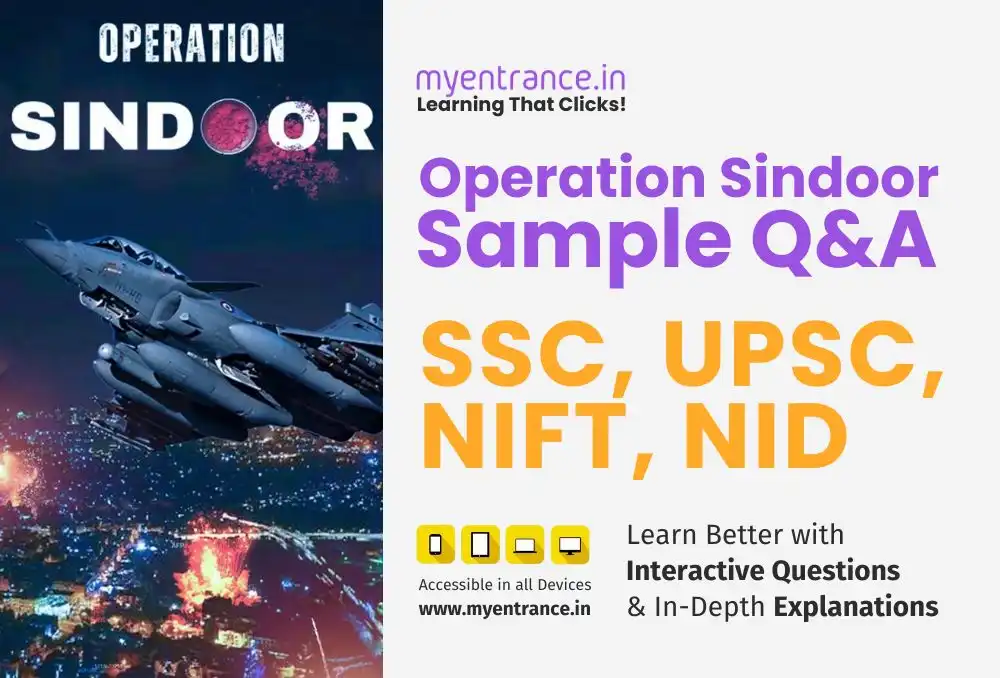Select Language
Operation Sindoor Explained: A Must-Know for NIFT, NID, UPSC & SSC Exams
In the wake of the Pahalgam terror attack in April 2024, India launched Operation Sindoor, a sweeping action against undocumented immigrants. This high-stakes security drive has major implications for internal security, federal coordination, and human rights—making it a crucial topic for exams like UPSC and SSC.
What Sparked Operation Sindoor?
After the terror attack in Pahalgam (April 2024), a national verification drive was launched to identify and remove illegal immigrants, primarily from Bangladesh.
How Was the Operation Conducted?
Detention of undocumented migrants followed by IAF airlift to border states.
BSF (Border Security Force) managed temporary camps.
Migrants received basic amenities, including food and Bangladeshi currency, before being repatriated.
Scale & States Involved:
Over 2,000 people were pushed back, and thousands more left voluntarily fearing detention.
Gujarat accounted for nearly 50% of all documented cases.
Other states involved: Assam, Tripura, Meghalaya, Delhi, Haryana.
Legal Foundation:
Operation grounded in the Foreigners Act, 1946 and the Passport (Entry into India) Act, 1920.
30-day document verification process led by states.
Notably, Delhi reported 97% of those checked had valid documents, highlighting significant false alarms or procedural lapses.
Governance & Coordination:
Meghalaya, a non-BJP state, participated actively—proving operational needs often transcend political lines.
Central and state governments coordinated through law enforcement and Foreigners Regional Registration Offices (FRROs).
Security & Humanitarian Issues:
Security threats include terror infiltration, fake IDs, and overstretched resources.
Humanitarian concerns like refoulement (forcing return of asylum seekers to dangerous zones) violate international norms.
Border Guards Bangladesh (BGB) played a key role in ensuring peaceful repatriation.
Key Themes:
Federal coordination challenges—varying detention infrastructure across states.
Article 21 implications—the balance between national security and humane treatment.
Lack of centralized illegal immigrant data—hinders long-term policy decisions.
Call for integrated tech—e.g., biometric IDs to prevent future infiltration.
Sample UPSC-Oriented Questions & Answers
Q1. What’s the difference between ‘pushback’ and deportation in the context of Operation Sindoor?
A1. Pushback involves the immediate expulsion of individuals across the border, typically without judicial process, whereas deportation follows a formal legal procedure under the Foreigners Act, 1946.
Q2. Why is Meghalaya’s participation in Operation Sindoor considered politically significant?
A2. Meghalaya, ruled by a non-BJP party, joined the operation due to its border geography, signaling a cooperative federal approach over party politics.
Q3. What legal provision allowed for the deportation of undocumented migrants?
A3. The Foreigners Act, 1946 empowers the government to detain and deport non-citizens lacking proper documentation.
Q4. What role do FRROs play in the deportation process?
A4. FRROs (Foreigners Regional Registration Offices) are responsible for verifying migrants’ legal status and coordinating with local authorities for detention and repatriation.
Q5. Mention one humanitarian issue raised by Operation Sindoor.
A5. A key concern is the risk of refoulement, where genuine asylum seekers could be returned to places of persecution, violating international human rights standards.
Most Predicted Questions
Comprehensive study materials, Expert-guided tips & tricks, Mock tests and instant results.
Start your SSC/ PSC/ NIFT/ NID journey today with MyEntrance, your ultimate online coaching platform.








